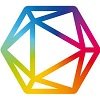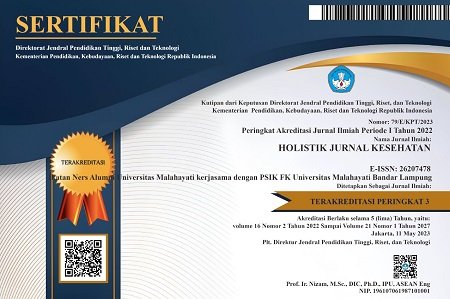Optimalisasi teknologi kecerdasan buatan (artificial intelligence) untuk menentukan skala prioritas diagnosa keperawatan anak: A literature review
Abstract
Background: A year in which significant technological changes have occurred. The theory consistently reviews childcare as a process of providing comprehensive and holistic health services to children to improve health, well-being and quality of life. However, this process is not easy and requires in-depth knowledge and correct decision making to diagnose, plan and provide appropriate nursing care.
Purpose: To analyze the latest information about the use of artificial intelligence (AI) technology that can be used in determining the priority scale for diagnosing child deaths.
Method: Literature review, a search for academic articles through online databases from 2019-2021 and obtained 10 suitable articles.
Results: The use of Artificial Intelligence applications is increasingly important to advance information to account for changes, it could be said that technology is becoming more sophisticated. However, this technology is still quite controversial in the healthcare industry because it is not yet universally available to provide nursing care, considering the nature of healthcare, ethical issues that can threaten patient preferences, security and privacy.
Conclusion: The use of AI applications is increasingly important to advance information to take into account changes, it could be said that technology is becoming more sophisticated. However, this technology is still quite controversial in the healthcare industry because it is not yet universally available to provide nursing care, considering the nature of healthcare, ethical issues that can threaten patient preferences, security and privacy.
Keywords: Artificial Intelligence; Nursing Diagnosis; Pediatric Nursing.
Pendahuluan: Tahun dimana perubahan teknologi yang signifikan telah terjadi. Teori ditinjau secara konsisten asuhan keperawatan anak merupakan proses pemberian pelayanan kesehatan yang komprehensif dan holistik kepada anak untuk meningkatkan kesehatan, kesejahteraan, dan kualitas hidup. Namun proses ini tidak mudah dan memerlukan pengetahuan mendalam serta pengambilan keputusan yang tepat untuk mendiagnosa, perencanaan dan memberikan asuhan keperawatan yang tepat.
Tujuan: Untuk menganalisis informasi terbaru tentang penggunaan teknologi artificial intelligence (AI) bisa digunakan dalam menentukan skala prioritas diagnosa keperawatan anak.
Metode: Literature review sebuah penelusuran artikel akademik melalui online database dari tahun 2019-2021 dan didapatkan 10 artikel yang sesuai.
Hasil: Penggunaan aplikasi Artificial Intelligence semakin penting untuk memajukan pengetahuan keperawatan untuk memperhitungkan perubahan, bisa dibilang teknologi semakin mutakhir. Namun teknologi ini masih cukup kontroversial di industri perawatan kesehatan karena belum tersedia secara menyeluruh untuk menyediakan asuhan keperawatan, dengan mempertimbangkan sifat layanan kesehatan, masalah etika yang dapat mengancam preferensi, keamanan, dan privasi pasien.
Simpulan: Penggunaan aplikasi AI semakin penting untuk memajukan pengetahuan keperawatan dalam memperhitungkan perubahan, bisa dibilang teknologi semakin mutakhir. Namun teknologi ini masih cukup kontroversial di industri perawatan kesehatan karena belum tersedia secara menyeluruh untuk menyediakan asuhan keperawatan, dengan mempertimbangkan sifat layanan kesehatan, masalah etika yang dapat mengancam preferensi, keamanan, dan privasi pasien.
Kata Kunci: Kecerdasan Buatan; Diagnosa Keperawatan; Keperawatan Anak.
Keywords
References
Banerjee, A., Chakraborty, C., Kumar, A., & Biswas, D. (2020). Emerging trends in IoT and big data analytics for biomedical and health care technologies. Handbook of data science approaches for biomedical engineering, 121-152.
Buchanan, C., Howitt, M. L., Wilson, R., Booth, R. G., Risling, T., & Bamford, M. (2020). Nursing in the age of artificial intelligence: Protocol for a scoping review. JMIR research protocols, 9(4), e17490.
Clarke, S. L., Parmesar, K., Saleem, M. A., & Ramanan, A. V. (2021). Future of machine learning in paediatrics. Archives of Disease in Childhood.
Fritz, R. L., & Dermody, G. (2019). A nurse-driven method for developing artificial intelligence in “smart” homes for aging-in-place. Nursing outlook, 67(2), 140-153.
Gerich, H. V., Moen, H., Block, L. J., Chu, C. H., DeForest, H., Hobensack, M., Michalowski, M., Mitchell, J., Nibber, R., Olalia, M. A., Pruinelli, L., Ronquillo, C. E., Topaz, M., & Peltonen, L. M. (2022). Artificial Intelligence-based Technologies in Nursing: A scoping Literature Review of the Evidence. International Journal of Nursing Studies (Elsevier); S0020748921002984
Gibelli, F., Ricci, G., Sirignano, A., Turrina, S., & De Leo, D. (2021). The increasing centrality of robotic technology in the context of nursing care: bioethical implications analyzed through a scoping review approach. Journal of Healthcare Engineering, 2021.
Harmon, J., Pitt, V., Summons, P., & Inder, K. J. (2021). Use of Artificial Intelligence and Virtual Reality Within Clinical Simulation for Nursing Pain Education: A Scoping Review. Nurse Education Today (Elsevier); https://www.sciencedirect.comS0260691720315501
Hartati, S. (2021). Kecerdasan Buatan Berbasis Pengetahuan. UGM Press.
Karim, A., Bangun, B., Purnama, I., Harahap, S. Z., Irmayani, D., Nasution, M., & Munthe, I. R. (2020). Pengantar teknologi informasi. Yayasan Labuhanbatu Berbagi Gemilang.
Khan, Z. F., & Alotaibi, S. R. (2020). Applications of artificial intelligence and big data analytics in m-health: a healthcare system perspective. Journal of healthcare engineering, 2020, 1-15.
Kustiyanti, S. A. (2023). Smart Hospital: Konsep, Implementasi, dan Tantangan. Transformasi Rumah Sakit Indonesia Menuju Era Masyarakat, 5, 161.
Lee, D., & Yoon, S. N. (2021). Application of artificial intelligence-based technologies in the healthcare industry: Opportunities and challenges. International Journal of Environmental Research and Public Health, 18(1), 271.
Liang, H. F., Wu, K. M., Weng, C. H., & Hsieh, H. W. (2019). Nurses' views on the potential use of robots in the pediatric unit. Journal of pediatric nursing, 47, e58-e64.
Li, J. P. O., Liu, H., Ting, D. S., Jeon, S., Chan, R. P., Kim, J. E., & Ting, D. S. (2021). Digital technology, tele-medicine and artificial intelligence in ophthalmology: A global perspective. Progress in retinal and eye research, 82, 100900.
O'Connor, S., Yan, Y., Thilo, F. J., Felzmann, H., Dowding, D., & Lee, J. J. (2023). Artificial intelligence in nursing and midwifery: A systematic review. Journal of Clinical Nursing, 32(13-14), 2951-2968.
Oniani, S., Marques, G., Barnovi, S., Pires, I. M., & Bhoi, A. K. (2021). Artificial intelligence for internet of things and enhanced medical systems. Bio-inspired neurocomputing, 43-59.
Ortigosa, A. M., Granados, A. M., Hernandez, E. G., Arrastia, M. R., Padilla, C. R., & Roman, P. (2023). Applications of Artificial Intelligence in Nursing Care: A Systematic Review. Journal of Nursing Management Journal of Nursing Management (Hindawi); https://jonm/2023/3219127/
Seibert, K., Domhoff, D., Bruch, D., Schulte-Althoff, M., Fürstenau, D., Biessmann, F., & Wolf-Ostermann, K. (2021). Application scenarios for artificial intelligence in nursing care: rapid review. Journal of medical Internet research, 23(11), e26522.
Wynn, M., Cross, L. G., Vasilica, C., & Davis, D. (2022). Digital Nursing Practice Theory: A Scoping and Thematic Analysis. Journal of Advance Nursing (JAN); https://onlinelibrary.wiley.com/jan.15660
Yunus, M., Kesuma, T. M., Diah, M., Yusuf, F., Abubakar, A., Rizal, S., & Zikran, G. (2023). Hospitality Hospital Management. Syiah Kuala University Press.
DOI: https://doi.org/10.33024/hjk.v17i10.13304
Refbacks
- There are currently no refbacks.
Copyright (c) 2024 Holistik Jurnal Kesehatan

This work is licensed under a Creative Commons Attribution-NonCommercial 4.0 International License.














